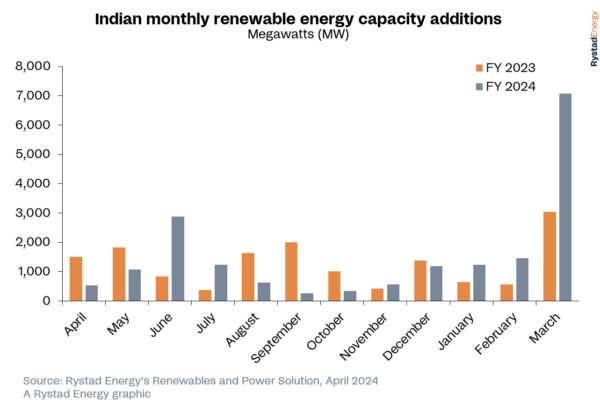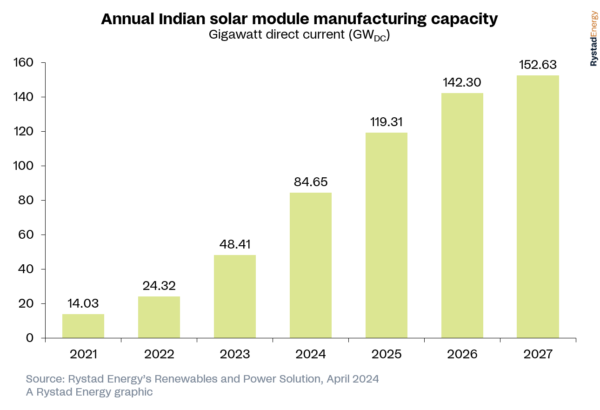India set a new record for monthly renewable energy installations by deploying 7.1 GW of capacity in March 2024. Monthly renewable energy additions included more than 6.2 GW of solar energy.
From pv magazine india
India’s monthly renewable energy installations reached a record 7.1 GW in March 2024, up from the previous record of 3.5 GW set in March 2022, latest figures from Rystad Energy show. More than 6.2 GW of the March 2024 total was new solar capacity – a remarkable one considering that the January to December 2023 period saw 7.5 GW of new solar installations.
A surge in renewable energy in March helped India reach its highest annual installed capacity of 18.5 GW for the fiscal year ending March 31, 2024.
Rystad Energy said that [annual] The growth in renewable energy capacity was mainly driven by solar installations, which increased by 23% compared to FY23, driven by the commissioning of multiple projects on India’s interstate transmission system grid and super mega solar park plans. In particular, states like Gujarat, Rajasthan, Madhya Pradesh and Maharashtra have contributed to this expansion.
Adani Green, the renewable energy unit of the Adani Group of India, took major steps in the first quarter of 2024 by installing approximately 1.6 GW of solar capacity in Gujarat’s Kutch region. The initiative is part of a wider hybrid renewable energy park that will see up to 30 GW of combined solar and wind capacity installed in Khawda in the coming years.

While recent increases in renewable energy capacity are encouraging, additional growth in annual deployment is key to meeting the country’s goal of achieving 500 GW of non-fossil fuel capacity by 2031-32. To reach the 500 GW target, India needs to install about 30 GW of non-fossil energy generation capacity annually, including solar, hydroelectric, onshore wind and nuclear power.
With India’s general elections beginning earlier this month, the country’s emphasis on renewable energy comes as no surprise. Rohit Pradeep Patel, vice president of renewable energy and energy research at Rystad Energy, said: “Despite the ambitious climate targets to reduce carbon dioxide emissions, achieving them is only possible if the country maintains the enthusiasm of recent months.” . However, critical challenges remain: ensuring grid sustainability alongside the higher integration costs associated with the introduction of more renewable capacity. A strategic solution is aimed at balancing this clean energy with targeted exports and enabling India’s growth prospects for the power sector, without compromising national climate goals.
On the supply chain side, the increase in solar installations in India has created a significant demand for solar equipment.
Historically, Indian developers have relied heavily on Chinese imports due to their competitive pricing compared to domestic manufacturers. In response, the Indian government has introduced initiatives such as the Production Linked Incentive (PLI) scheme to help domestic manufacturers strengthen their manufacturing capabilities.
In addition, government support measures such as the Approved List of Models and Manufacturers (ALMM) order and basic customs duties on imported solar modules have also helped boost the domestic solar industry. Backed by these measures, India’s solar panel production capacity reached 68 GW in March 2024, and the country began to expand its reach by exporting panels.

The US market has emerged as a major export destination due to its high demand for solar energy and the potential for strong profit margins. The Uighur Forced Labor Prevention Act (UFLPA) in the US has also contributed to this shift towards Indian products.
Although millions of panels are shipped from India to the US market, Indian manufacturers face stiff competition from their Southeast Asian counterparts, which can lower production costs by using raw materials from China.
However, exports from India are expected to increase as the US imposes tariffs on panels from Southeast Asian manufacturers. It is expected to be up to 254 percent and is likely to be implemented from June 2024, making Southeast Asian panels significantly more expensive than Indian panels.
This content is protected by copyright and may not be reused. If you would like to collaborate with us and want to reuse some of our content, please contact: editors@pv-magazine.com.
#Indias #solar #installations #reached #March